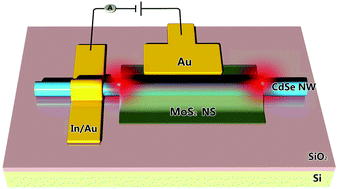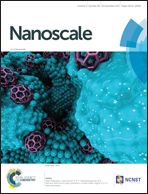A mixed-dimensional light-emitting diode based on a p-MoS2 nanosheet and an n-CdSe nanowire†
Abstract
The construction of the mixed-dimensional van der Waals (vdW) heterostructures with two-dimensional (2D) and one-dimensional (1D) materials can advantageously integrate their respective dimensional properties to produce new device functionalities and/or enhance device performance. In this case, a single semiconductor nanowire (NW) can function as an optical cavity and a gain medium, while the atomically thin 2D material does not strongly absorb the NW's light emission or disturb the optical propagation mode. Therefore, the mixed-dimensional 2D/1D vdW heterostructure might provide a new route to realize high-efficiency light-emitting diodes (LEDs) and/or even electrically driven lasers. Here, we report a LED based on a p-type MoS2 nanosheet and an n-type CdSe NW. The 2D/1D vdW heterojunction diode exhibits a rectification ratio of ∼24 at Vds = ±3 V, and a low turn-on voltage of ∼1.5 V. Under the forward bias exceeding the turn-on voltage, the 2D/1D vdW heterojunction exhibits strong electroluminescence centered at ∼709 nm, corresponding to the band-edge emission of the CdSe NW. This novel 2D/1D vdW device, which takes advantages of both 2D and 1D semiconductors, enables potential future applications in electrically driven lasers, high-sensitivity sensors, and transparent flexible devices.



 Please wait while we load your content...
Please wait while we load your content...